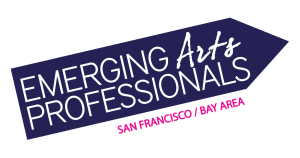Evolve & Vocalize: What can we do now?
– Change in trickled down funding
– Offering micro-grants
– Identifying a different business model
– Find a way to get more money for the independent artist
– Assign someone under 30 on the board
– Advocacy, Becoming knowledgeable about legislation that affects the arts
– Funders round table
– Education for both artists and founders
– Continue to nourish opportunities for potential collaborations and networking
– Arts + political involvement
– Identifying and funding artists healthcare as well as sustainable survival
– Giving money for program development and process not just product
– Identifying/Creating Space, like Red Ink Studios in Hunters Point
– Collect best practices + finance information to share with emerging artists / organizations
– Develop internships for arts advocacy to support knowledge and action of/on legislation
– Support the work of SF BAEAP
– Build cross disciplinary programs to support shared goals
– Identify symbiotic relationships between institutions
– Mentorship programs for administrators of artists run spaces and community arts organizations
– Plugging into existing communities i.e. critique groups, artist run spaces, etc
– Networking – hearing other people stories
– Resist the desire to be all things to all people
– Make friends who have insight (explore need for partnerships)
– Clarifying our mission
– Forums, networks building bridges
– Foster connections
– Create a website for people to interact
– Offer professional development opportunities
– Offer a space for people to barter services (on website)
– Create book clubs
– Exchange of art and non art sectors
– Partnerships – match making
– Create Professional mentorship programs
– Create an advisory board – with specific roles
– Emphasize work/life balance
– Offer organizational support towards personal art practice, professional development and social benefits
– Opportunity to interact as artists not just “arts professionals”
– Professional mentorship opportunities
– Build philosophy of continued learning/development built into job description or mission
– Creativity model: TED.COM
– A collective voice to share our outcomes as artist to broad communities.
– Share outcome with other cross-disciplinary artists as well
– Meaningful collaborations across diverse platforms for showcasing one another, a more social (more arts, less production work) sustainable and fun.
– Meeting model: Meet-up.com (people sharing what they are working on, while having fun.
– Stride towards a tangible connection between arts thinking and street level / community level contexts.
– Provide a dedicated space (arts center with housing)
– Offer a portal for how for-profits/non profits can work with one another
– Our community – Artistic + design thinking
– Increase the bottom up input model (communities, artist, bottom level workers)
– Offer entrepreneurial programs
– Offer creative workshops, services for corporations
– Help individual artists navigate while positioning themselves in a capitalist workforce (diversify their offerings)
– Online/off line networking opportunities
– Bridging gaps between generations
– Advocating for a new model – the Obama Model
– How to run a self sustainable organization with low funds
– Mentorship program to share skills between emerging and established art professionals
– Set a bulleting board for members interaction
– Facilitate a barter system
– Time to get together to identify specific topics “Support Groups” Meet-up.com
– Artistic administrative counseling on communication (organizational coach)
– Helping to identify a career trajectory and leveraging skills
– Educating current leaders about resources within community – how can it benefit the organization?
– Meet more
– Identify issues
– Organize workshops
– Get to know our community challenges /solutions
– Share resources
– Find allies
– Find common goals
– Work on different strategies
– How do we articulate our strengths? Capitalize on creativity.
– Prevent burnout / artist isolation
– Fund research and advocate on impact of the arts – How can we bring this perspective into our organizations?
– Increase collaborations and partnerships
– Get more funds for office operations and administrative costs
– Help create giving circles
– When resources are scarce, how do organizations/artists make time, think about new approaches/models
– Transfer of knowledge inter-organization – communication is key
– Affect career centers at universities
– Recognizing your own value as an artist
– Offer an avenue for community to vent (network affiliation)
– Or vent by redefining roles – owning craft, making your own community
– Value yourself / confidence / worth (skills)
– Understand options (+/-) for sustainability
– Make real world solutions available and transferable
– Offer training in writing a business plan
– Knowing your worth instead of seeking external validation for $
– What IS the next step?
– Teach Teamwork vs. corporate models
– Block / protect soul sucking
– Teach how one can balance methods for making a living
o How to maintain fiscal sustainability
– A culture of service – education/theater/health, science, food/nutrition
– Tap into the diversity
– Definition of community – Regional vs. local
– Arts advocacy and economic development
– Recognize that competition for funding discouraging alliances
– Translate policy language
– Fund arts administration degrees
– Stop recreating the wheel!
– Experimentation – art as research
– Teach people to become their own advocates
– Help people develop the language they need
– Develop a culture of natural mentorship
– Building learning communities
– Cross pollinate ideas/programs/people
– Create a mentorship blueprint
– Offer career path counseling
– Can BEAEAP be the repository or information source or cleaning house for case studies of art career paths
– What already exists – opportunities, life styles, communities, +/- attributes framework
– Act as a resource radar and transparency
– Information sharing about opportunities for professional development
– Emphasizing importance skills value or artists in professional sector
– Keep asking questions, infuse new ideas
– Key: grass roots, volunteer and DYI environments
– Distilling the many opportunities within the bay area

Trackbacks & Pingbacks
[…] Question 2: What can we do now? […]
Leave a Reply
Want to join the discussion?Feel free to contribute!